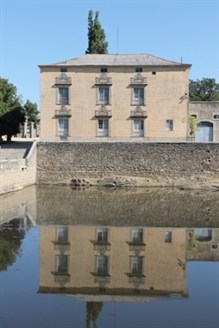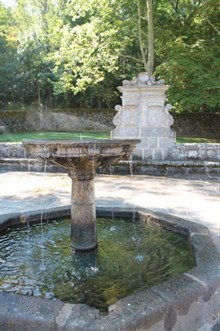Lakes and fountains in the “Bosque” of Béjar: the use of water in a courtly villa
 One of the distractions in the courtly life of the Dukes of Béjar in the Bosque was linked to the particular use of water. The result was a set of roads, canals, fountains and a lake that provided refreshment on Summer days, guaranteed the life of animals and plants and represented the power of the patron family through the coats of arms carved on the walls of the lake and fountains. The artificial lake of Béjar‘s Bosque was converted into a fundamental element of the garden. It dominated the main terrace of the villa, occupied an area of 4,322 square metresand, was, without doubt, a great feat of engineering, with channels and dams to govern the river. In addition, the still waters of the lake gave tranquility and served to give breadth of perspective, as they served as a large mirror of the palace, which was reflected in them (image 1). On the surface, around a Neo-Moorish temple of the nineteenth century, there were, as you can still see, several species of birds and aquatic animals. Pedro Juan de LastanosaA famous mathematician and engineer of the second half of the sixteenth century, who was in the service of Philip II. He was responsible for major engineering projects like the Canal Imperial of Aragón or the Alcázar of Madrid, the palace of the Habsburg monarchs. He also wrote several treatises on mathematics and engineering., Philip II‘s engineer of hydraulic machines, explained the interest of the nobility in the construction of lakes as if they were authentic fish ponds in his work Los veintiún libros de los ingenios y de las máquinas in which they delighted in feeding them and seeing the competition between animals for their rations of food. Other recreational activities in the Bosque‘s lake were sailing, angling or representations of naval battles through naumachieDramatization of naval battles in lakes and pools, which dates back to Roman times. (although the real existence of latter activity has created a heated debate among scholars of Béjar as to the unreliability of the information contained in the sources).
One of the distractions in the courtly life of the Dukes of Béjar in the Bosque was linked to the particular use of water. The result was a set of roads, canals, fountains and a lake that provided refreshment on Summer days, guaranteed the life of animals and plants and represented the power of the patron family through the coats of arms carved on the walls of the lake and fountains. The artificial lake of Béjar‘s Bosque was converted into a fundamental element of the garden. It dominated the main terrace of the villa, occupied an area of 4,322 square metresand, was, without doubt, a great feat of engineering, with channels and dams to govern the river. In addition, the still waters of the lake gave tranquility and served to give breadth of perspective, as they served as a large mirror of the palace, which was reflected in them (image 1). On the surface, around a Neo-Moorish temple of the nineteenth century, there were, as you can still see, several species of birds and aquatic animals. Pedro Juan de LastanosaA famous mathematician and engineer of the second half of the sixteenth century, who was in the service of Philip II. He was responsible for major engineering projects like the Canal Imperial of Aragón or the Alcázar of Madrid, the palace of the Habsburg monarchs. He also wrote several treatises on mathematics and engineering., Philip II‘s engineer of hydraulic machines, explained the interest of the nobility in the construction of lakes as if they were authentic fish ponds in his work Los veintiún libros de los ingenios y de las máquinas in which they delighted in feeding them and seeing the competition between animals for their rations of food. Other recreational activities in the Bosque‘s lake were sailing, angling or representations of naval battles through naumachieDramatization of naval battles in lakes and pools, which dates back to Roman times. (although the real existence of latter activity has created a heated debate among scholars of Béjar as to the unreliability of the information contained in the sources).
 In the Bosque there are two major fountains, the first is the Fuente de los Ocho Caños (the Fountain of the Eight Jets), dating from the late sixteenth century, situated next the lake and opposite the Palace of the Dukes. It consists of an octagonal column and a bowl that collects the water with eight figures of mythological animals such as newts, fauns, etc.. At the bottom of this fountain you can see the Zúñiga y Sotomayor coats of arms (picture 2). Further north, next to the palace, is the Fuente de la Sábana (the Fountain of the Sheet), built at the beginning of the eighteenth century in Baroque style. Its name refers to the lightness of the water, which resembles the motion of a draping sheet. The Zúñiga y Sotomayor coat of arms dominate the highest part of the fountain, in a kind of Baroque coronation.
In the Bosque there are two major fountains, the first is the Fuente de los Ocho Caños (the Fountain of the Eight Jets), dating from the late sixteenth century, situated next the lake and opposite the Palace of the Dukes. It consists of an octagonal column and a bowl that collects the water with eight figures of mythological animals such as newts, fauns, etc.. At the bottom of this fountain you can see the Zúñiga y Sotomayor coats of arms (picture 2). Further north, next to the palace, is the Fuente de la Sábana (the Fountain of the Sheet), built at the beginning of the eighteenth century in Baroque style. Its name refers to the lightness of the water, which resembles the motion of a draping sheet. The Zúñiga y Sotomayor coat of arms dominate the highest part of the fountain, in a kind of Baroque coronation.
Finally, beside the Fuente de la Sábana, you must admire a legendary tree, the tejo del Bosque, the oldest tree on the property, which may have been planted when the garden was created. There are also other trees, a group of redwoods, which although they are not as old as the tejo, are impressive for their great height and grandeur.
